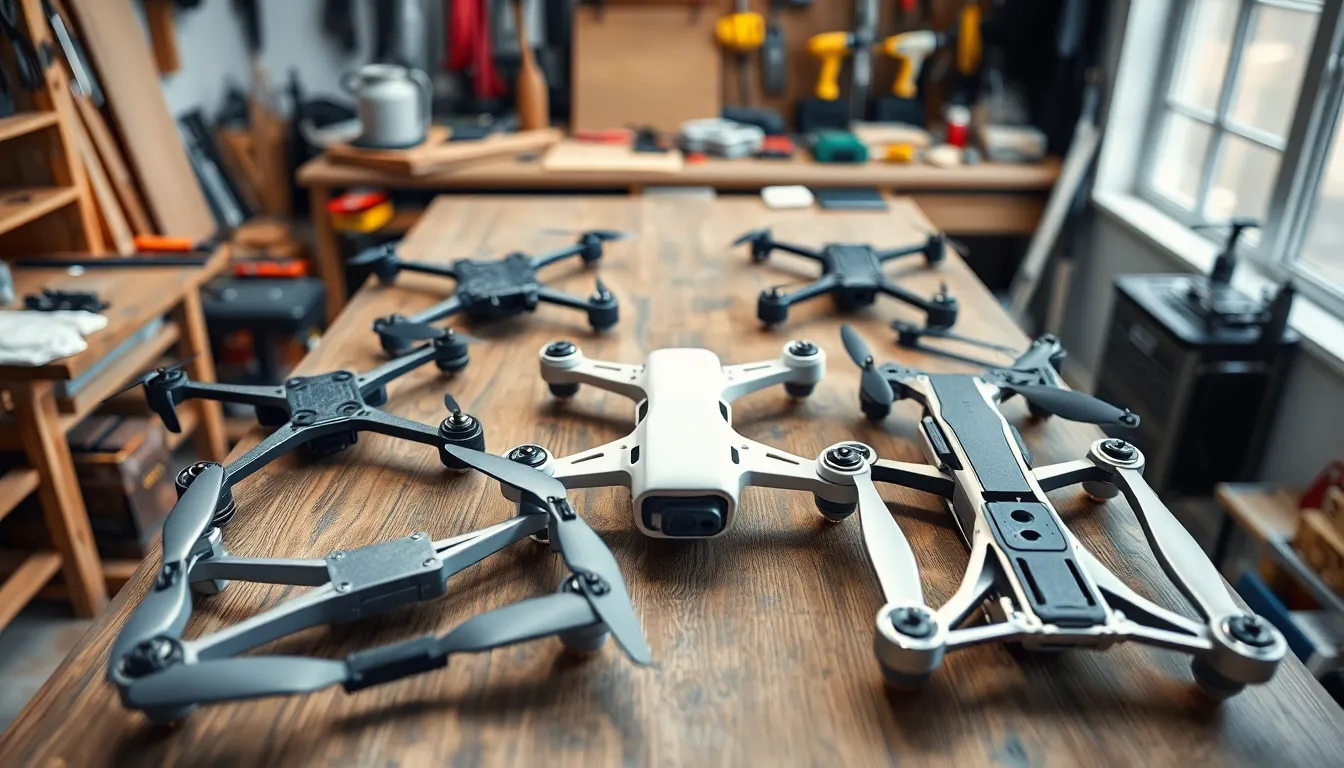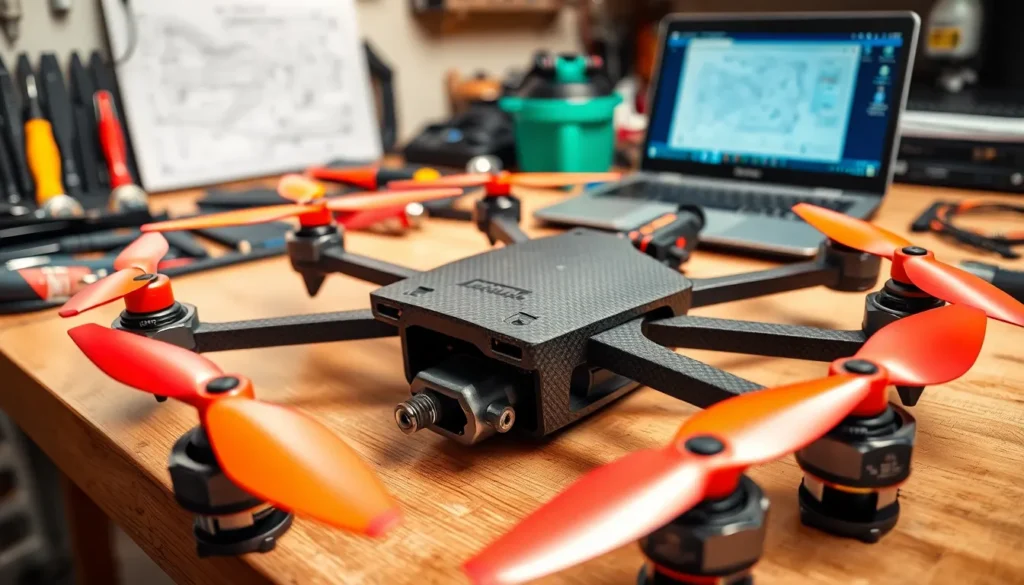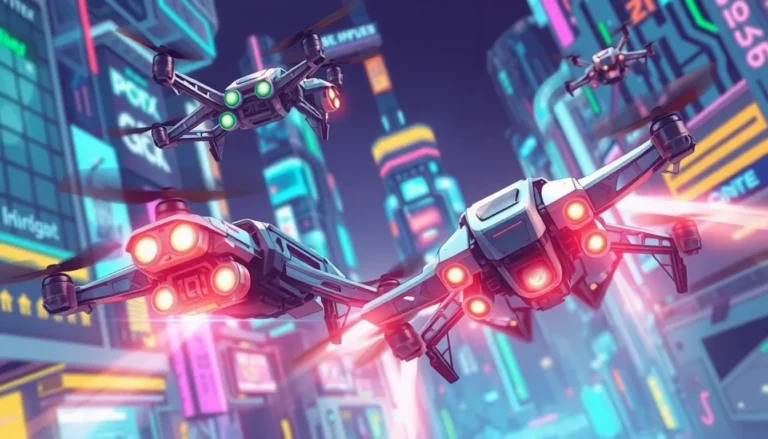Table of Contents
ToggleDrones are the superheroes of the tech world, soaring through the skies with grace and precision. But behind every aerial acrobatics lies a complex array of hardware components that make the magic happen. Understanding these parts is like knowing the secret sauce to your favorite dish—without it, things just don’t taste right.
Overview of Drone Hardware Components
Drones consist of various hardware components that work together to deliver superior performance. Flight controllers serve as the brain, processing data from sensors and managing flight dynamics. Propellers generate lift and thrust, enabling the drone to navigate through different environments.
Battery systems provide the necessary power, with lithium polymer (LiPo) batteries being popular for their high energy density. Motors convert electrical energy into mechanical energy, determining the drone’s speed and agility.
In addition, frames hold all components together, contributing to strength and durability. Different designs suit specific needs, such as racing or aerial photography.
Sensors enhance a drone’s capabilities, with GPS modules offering precise positioning data. Cameras provide real-time video feeds, crucial for a range of applications from surveying to search and rescue operations.
Transceivers enable communication between the drone and the operator, ensuring control over distances. Ground control stations may also integrate with drones for monitoring and adjustments.
Understanding these hardware components reveals how they collectively contribute to a drone’s functionality and versatility. Each part plays a critical role, enhancing its operational efficiency in various applications.
Frame Material and Design

Frame materials and design greatly influence a drone’s performance and durability. Selecting the right combination ensures that a drone meets its intended purpose.
Types of Frame Materials
Carbon fiber, plastic, and aluminum are common frame materials. Carbon fiber offers lightweight strength, making it suitable for racing drones. Plastic frames provide cost-effectiveness and durability, often used in hobbyist drones. Aluminum adds rigidity and resistance to impact, which benefits industrial applications. Each material type has unique properties that affect weight, strength, and flexibility, influencing the drone’s overall performance.
Importance of Frame Design
Frame design significantly impacts drone maneuverability and stability. Aerodynamic shapes reduce drag while enhancing flight efficiency. Additionally, modular designs simplify repairs and upgrades, allowing users to customize their drones easily. Beat sensitivity and vibration dampening play crucial roles in maintaining stable flight, especially for aerial photography. A well-thought-out frame design accommodates various components, optimizing weight distribution and enhancing overall functionality.
Propulsion System
The propulsion system drives the drone’s movement, encompassing essential components like motors, propellers, and electronic speed controllers. Each element plays a crucial role in achieving efficient flight.
Motors and Propellers
Motors convert electrical energy into kinetic energy, generating the necessary thrust. Different motor types, like brushless motors, provide efficiency and longevity for drones. Propellers work in tandem with these motors, providing lift and direction. Various sizes affect performance: larger propellers deliver more lift, while smaller ones enhance speed. Material choices like carbon fiber or plastic impact durability and weight. Each drone’s design incorporates a combination of motor and propeller specifications to meet its intended purpose.
Electronic Speed Controllers (ESC)
Electronic speed controllers manage the power sent to the motors, ensuring they operate smoothly and efficiently. Each ESC connects directly to the drone’s flight controller, receiving commands for speed adjustments. These components assist in stabilizing the drone during flight, allowing for precise control. Ratings for ESCs depend on the motor’s specifications, ensuring compatibility with varied setups. High-quality ESCs contribute to longer flight times and better performance, especially under load. Integration of the ESC into the system proves vital for optimizing maneuverability and response.
Power Supply and Battery
Power supply and battery systems are crucial for drone performance. These components determine flight duration and overall efficiency.
Battery Types and Specifications
Common battery types include lithium polymer (LiPo), nickel-metal hydride (NiMH), and lithium-ion (Li-ion). LiPo batteries dominate the market due to their high energy density and lightweight nature. A typical 3S LiPo battery provides approximately 11.1 volts with capacities ranging from 1000 mAh to 5000 mAh. NiMH batteries offer less power but can be more resilient to damage, often used in lower-end drones. Meanwhile, Li-ion batteries boast durability and are often employed in larger or high-end drones due to their extended cycle life. Each battery type’s specifications, such as discharge rates and milliamp-hour ratings, directly influence flight time and stability.
Power Management Systems
Effective power management systems enhance battery efficiency and drone safety. These systems monitor battery voltage and current, ensuring optimal usage during flight. Battery management systems (BMS) prevent over-discharge, balancing individual cells for longer life. Additionally, features like voltage alarms notify users of low battery levels, prompting timely landings. Some drones utilize smart ESCs capable of adjusting power delivery based on flight requirements, enhancing performance in various conditions. By integrating these systems, drones achieve better flight efficiency and safety across diverse operational scenarios.
Sensors and Navigation
Sensors play a crucial role in enhancing drone capabilities. They gather real-time data, allowing drones to navigate complex environments.
Common Sensors Used in Drones
GPS modules enable precise location tracking, essential for navigation and mapping. Cameras capture high-resolution images and videos, serving multiple applications including aerial photography and surveillance. Lidar sensors provide accurate distance measurements, useful in terrain mapping and obstacle avoidance. Ultrasonic sensors assist in altitude measurement, helping drones maintain consistent heights during flight. In addition, IMUs detect changes in orientation and acceleration, ensuring stable flight dynamics. These various sensors work in harmony to enhance a drone’s operational efficiency across diverse scenarios.
Navigation Systems Overview
Navigation systems guide drones with powerful technologies. Inertial navigation systems combine data from IMUs and GPS for accurate positioning. Ground control stations facilitate communication between the operator and the drone, providing essential updates and commands. Autonomous navigation relies on software algorithms to plot optimal flight paths, reducing human error. Additionally, waypoint navigation enables pre-programmed routes, enhancing ease of use. These systems together ensure that drones operate safely and effectively, adapting to different flying conditions and missions.
Understanding the hardware components of drones is essential for anyone interested in this technology. Each part plays a vital role in ensuring optimal performance and functionality. From the flight controller to the propulsion system and sensors, every element contributes to a drone’s capabilities.
As drone technology continues to evolve, so do the components that support it. Staying informed about advancements in materials and designs can enhance users’ experiences and broaden the applications of drones. This knowledge not only empowers operators but also opens up new possibilities in various fields, from aerial photography to search and rescue missions. Embracing this understanding will undoubtedly lead to better, more efficient drone operations.







